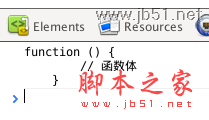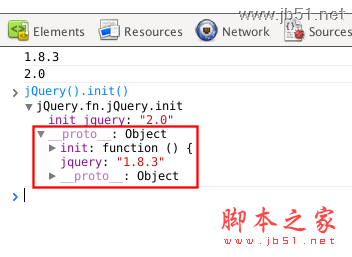巧妙1:函数
在javascript代码中函数是个不可多得的人才。
♥ 它可以归置代码段,封装相对独立的功能。
♥ 它也可以实现类,注入OOP思想。
jQuery就是一个函数,你也可以把它当成类(呵呵,本身就是类)。
(function(){
var jQuery = function() {
// 函数体
}
window.jQuery = window.$ = jQuery;
})();
console.log(jQuery);

上面的空函数就是所谓的构造函数,构造函数在面向对象语言中是类的一个基本方法。
巧妙2:扩展原型
何为原型对象?我给出一篇博文大家可以去了解一下http://www.jb51.net/article/32857.htm。
javascript为所有函数绑定一个prototype属性,由这个属性指向一个原型对象。我们在原型对象中定义类的继承属性和方法等。
原型对象是javascript实现继承的基本机制。
(function(){
var jQuery = function() {
// 函数体
}
jQuery.fn = jQuery.prototype = {
// 扩展原型对象
jquery: "1.8.3",
test: function() {
console.log('test');
}
}
window.jQuery = window.$ = jQuery;
})();
(new jQuery()).test();
巧妙3:使用工厂方法来创建一个实例
上面的方法必须使用下面的方法才能进行调用,这样就会产生很多对象,从而浪费内存消耗。
(new jQuery()).test();
jQuery源码使用了很柔和的方法,也是大家比较熟悉的工厂方法,进行调用。
(function(){
var jQuery = function() {
// 函数体
return jQuery.fn.init();
}
jQuery.fn = jQuery.prototype = {
// 扩展原型对象
jquery: "1.8.3",
init: function() {
return this;
},
test: function() {
console.log('test');
}
}
window.jQuery = window.$ = jQuery;
})();
jQuery().test();

(function(){
var jQuery = function() {
return this;
}
jQuery.fn = jQuery.prototype = {
// 扩展原型对象
jquery: "1.8.3",
test: function() {
console.log('test');
}
}
window.jQuery = window.$ = jQuery;
})();
console.log(jQuery());
输出结果

假想2:让jQuery函数体直接返回类的实例。
(function(){
var jQuery = function() {
return new jQuery();
}
jQuery.fn = jQuery.prototype = {
// 扩展原型对象
jquery: "1.8.3",
test: function() {
console.log('test');
}
}
window.jQuery = window.$ = jQuery;
})();
console.log(jQuery());
输出结果

巧妙4:分隔作用域
思考1:init()方法返回的this作用域是什么?
(function(){
var jQuery = function() {
// 函数体
return jQuery.fn.init();
}
jQuery.fn = jQuery.prototype = {
// 扩展原型对象
jquery: "1.8.3",
init: function() {
this.init_jquery = '2.0';
return this;
}
}
window.jQuery = window.$ = jQuery;
})();
console.log(jQuery().jquery);
console.log(jQuery().init_jquery);
输出结果

init()方法中的this作用域:this关键字引用了init()函数作用域所在的对象,同时也能够访问上一级对象jQuery.fn对象的作用。——这种思路会破坏作用域的独立性,对于jQuery框架来说,很可能造成消极影响。
思考2:怎么把init()中的this从jQuery.fn对象中分隔出来?——实例化init初始化类型。
(function(){
var jQuery = function() {
// 函数体
return new jQuery.fn.init();
}
jQuery.fn = jQuery.prototype = {
// 扩展原型对象
jquery: "1.8.3",
init: function() {
this.init_jquery = '2.0';
return this;
}
}
window.jQuery = window.$ = jQuery;
})();
console.log(jQuery().jquery);
console.log(jQuery().init_jquery);
输出结果

通过实例化init()初始化类型,限定了init()方法里的this,只在init()函数内活动,不让它超出范围。
巧妙5:原型传递
思考1:在巧妙4中,我们把init()中的this从jquery.fn对象中分隔出来。那我们如何能做到保证“巧妙4”的基础上,还能访问jQuery原型对象呢?——原型传递。
让jQuery的原型对象覆盖init()构造器的原型对象。
jQuery.fn.init.prototype = jQuery.fn;
全部代码:
(function(){
var jQuery = function() {
// 函数体
return new jQuery.fn.init();
}
jQuery.fn = jQuery.prototype = {
// 扩展原型对象
jquery: "1.8.3",
init: function() {
this.init_jquery = '2.0';
return this;
}
}
jQuery.fn.init.prototype = jQuery.fn;
window.jQuery = window.$ = jQuery;
})();
console.log(jQuery().jquery);
console.log(jQuery().init_jquery);
输出结果

把init()对象的prototype指针指向jQuery.fn。——这样init()里的this继承了jQuery.fn原型对象定义的方法和属性。
总结
感谢博友的留言,尤其是puni ,给我介绍了一本不错的书。如果大家能补充一下,那就再好不过了。
 Python gegen JavaScript: Eine vergleichende Analyse für EntwicklerMay 09, 2025 am 12:22 AM
Python gegen JavaScript: Eine vergleichende Analyse für EntwicklerMay 09, 2025 am 12:22 AMDer Hauptunterschied zwischen Python und JavaScript sind die Typ -System- und Anwendungsszenarien. 1. Python verwendet dynamische Typen, die für wissenschaftliche Computer- und Datenanalysen geeignet sind. 2. JavaScript nimmt schwache Typen an und wird in Front-End- und Full-Stack-Entwicklung weit verbreitet. Die beiden haben ihre eigenen Vorteile bei der asynchronen Programmierung und Leistungsoptimierung und sollten bei der Auswahl gemäß den Projektanforderungen entschieden werden.
 Python vs. JavaScript: Auswählen des richtigen Tools für den JobMay 08, 2025 am 12:10 AM
Python vs. JavaScript: Auswählen des richtigen Tools für den JobMay 08, 2025 am 12:10 AMOb die Auswahl von Python oder JavaScript vom Projekttyp abhängt: 1) Wählen Sie Python für Datenwissenschafts- und Automatisierungsaufgaben aus; 2) Wählen Sie JavaScript für die Entwicklung von Front-End- und Full-Stack-Entwicklung. Python ist für seine leistungsstarke Bibliothek in der Datenverarbeitung und -automatisierung bevorzugt, während JavaScript für seine Vorteile in Bezug auf Webinteraktion und Full-Stack-Entwicklung unverzichtbar ist.
 Python und JavaScript: Verständnis der Stärken der einzelnenMay 06, 2025 am 12:15 AM
Python und JavaScript: Verständnis der Stärken der einzelnenMay 06, 2025 am 12:15 AMPython und JavaScript haben jeweils ihre eigenen Vorteile, und die Wahl hängt von den Projektbedürfnissen und persönlichen Vorlieben ab. 1. Python ist leicht zu erlernen, mit prägnanter Syntax, die für Datenwissenschaft und Back-End-Entwicklung geeignet ist, aber eine langsame Ausführungsgeschwindigkeit hat. 2. JavaScript ist überall in der Front-End-Entwicklung und verfügt über starke asynchrone Programmierfunktionen. Node.js macht es für die Entwicklung der Vollstapel geeignet, die Syntax kann jedoch komplex und fehleranfällig sein.
 JavaScripts Kern: Ist es auf C oder C aufgebaut?May 05, 2025 am 12:07 AM
JavaScripts Kern: Ist es auf C oder C aufgebaut?May 05, 2025 am 12:07 AMJavaScriptisnotbuiltoncorc; Es ist angehört, dass sich JavaScriptWasdedeSthatrunsonGineoFtencninc.
 JavaScript-Anwendungen: Von Front-End bis Back-EndMay 04, 2025 am 12:12 AM
JavaScript-Anwendungen: Von Front-End bis Back-EndMay 04, 2025 am 12:12 AMJavaScript kann für die Entwicklung von Front-End- und Back-End-Entwicklung verwendet werden. Das Front-End verbessert die Benutzererfahrung durch DOM-Operationen, und die Back-End-Serveraufgaben über node.js. 1. Beispiel für Front-End: Ändern Sie den Inhalt des Webseitentextes. 2. Backend Beispiel: Erstellen Sie einen Node.js -Server.
 Python vs. JavaScript: Welche Sprache sollten Sie lernen?May 03, 2025 am 12:10 AM
Python vs. JavaScript: Welche Sprache sollten Sie lernen?May 03, 2025 am 12:10 AMDie Auswahl von Python oder JavaScript sollte auf Karriereentwicklung, Lernkurve und Ökosystem beruhen: 1) Karriereentwicklung: Python ist für die Entwicklung von Datenwissenschaften und Back-End-Entwicklung geeignet, während JavaScript für die Entwicklung von Front-End- und Full-Stack-Entwicklung geeignet ist. 2) Lernkurve: Die Python -Syntax ist prägnant und für Anfänger geeignet; Die JavaScript -Syntax ist flexibel. 3) Ökosystem: Python hat reichhaltige wissenschaftliche Computerbibliotheken und JavaScript hat ein leistungsstarkes Front-End-Framework.
 JavaScript -Frameworks: Stromversorgung moderner WebentwicklungMay 02, 2025 am 12:04 AM
JavaScript -Frameworks: Stromversorgung moderner WebentwicklungMay 02, 2025 am 12:04 AMDie Kraft des JavaScript -Frameworks liegt in der Vereinfachung der Entwicklung, der Verbesserung der Benutzererfahrung und der Anwendungsleistung. Betrachten Sie bei der Auswahl eines Frameworks: 1. Projektgröße und Komplexität, 2. Teamerfahrung, 3. Ökosystem und Community -Unterstützung.
 Die Beziehung zwischen JavaScript, C und BrowsernMay 01, 2025 am 12:06 AM
Die Beziehung zwischen JavaScript, C und BrowsernMay 01, 2025 am 12:06 AMEinführung Ich weiß, dass Sie es vielleicht seltsam finden. Was genau muss JavaScript, C und Browser tun? Sie scheinen nicht miteinander verbunden zu sein, aber tatsächlich spielen sie eine sehr wichtige Rolle in der modernen Webentwicklung. Heute werden wir die enge Verbindung zwischen diesen drei diskutieren. In diesem Artikel erfahren Sie, wie JavaScript im Browser ausgeführt wird, die Rolle von C in der Browser -Engine und wie sie zusammenarbeiten, um das Rendern und die Interaktion von Webseiten voranzutreiben. Wir alle kennen die Beziehung zwischen JavaScript und Browser. JavaScript ist die Kernsprache der Front-End-Entwicklung. Es läuft direkt im Browser und macht Webseiten lebhaft und interessant. Haben Sie sich jemals gefragt, warum Javascr


Heiße KI -Werkzeuge

Undresser.AI Undress
KI-gestützte App zum Erstellen realistischer Aktfotos

AI Clothes Remover
Online-KI-Tool zum Entfernen von Kleidung aus Fotos.

Undress AI Tool
Ausziehbilder kostenlos

Clothoff.io
KI-Kleiderentferner

Video Face Swap
Tauschen Sie Gesichter in jedem Video mühelos mit unserem völlig kostenlosen KI-Gesichtstausch-Tool aus!

Heißer Artikel

Heiße Werkzeuge

Sicherer Prüfungsbrowser
Safe Exam Browser ist eine sichere Browserumgebung für die sichere Teilnahme an Online-Prüfungen. Diese Software verwandelt jeden Computer in einen sicheren Arbeitsplatz. Es kontrolliert den Zugriff auf alle Dienstprogramme und verhindert, dass Schüler nicht autorisierte Ressourcen nutzen.

Herunterladen der Mac-Version des Atom-Editors
Der beliebteste Open-Source-Editor

SublimeText3 chinesische Version
Chinesische Version, sehr einfach zu bedienen

WebStorm-Mac-Version
Nützliche JavaScript-Entwicklungstools

Dreamweaver Mac
Visuelle Webentwicklungstools






